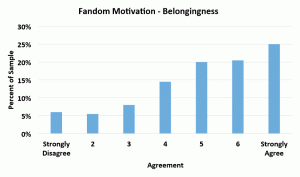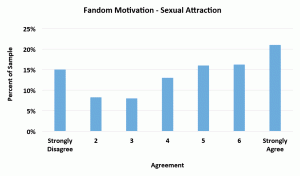There are numerous reasons to participate in the furry community, and it’s doubtless that if you were to ask furries why they participate in the fandom, you would get dozens of explanations. Fandom researchers argue, however, that fandom fulfills a number of different psychological functions, and that fandoms with dramatically different content (e.g., sports vs. science fiction) may, nevertheless, fulfill similar functions: the need to belong, self-esteem, entertainment, attention, even a psychological need for sex. To test this hypothesis, we asked furries whether they agreed or disagreed that each of several different factors contributed to their motivation to participate in the furry community.1
The results are displayed in the figures below, with each figure representing a different psychological need, and the bars representing the percent of participants who agreed, to varying degrees, that fulfilling that need was an important component of their fandom participation. Figures with very high bars on the right side provide strong evidence that satisfying that particular need is a powerful motivator for most furries.
For the most part, furries agree that the furry fandom fulfills a need to belonging to a group larger than oneself, a very important social need.2 In fact, the figure at right suggests that belongingness is a stronger motivator of fandom participation for furries than for members of other fandoms. 3
Whether the fandom fulfills a need to appreciate beauty seems to be contentious; about 50% of furries agree that being a furry provides a sense of beauty and aesthetic to their lives (most likely in reference to the art, writing or other creative works of the fandom). The spike on the left side of the figure, however, suggests that 10-20% of furries disagree vehemently with this idea. This may represent therians or others for whom artwork is not the main draw of the community, but who are instead drawn to by the opportunity to be with like-minded individuals.4

Similarly, there is a lot of disagreement about whether the fandom’s relationship to their self-esteem is a motivator for their participation. For many furries, participation in a community seems to be motivated, in part, by its association with their self-esteem (presumably improving it). However, for almost as many furries the opposite is true—that participation in the furry community is not at all motivated by their self-esteem. It’s possible that the stigma associated with being a furry5 may make it difficult for the fandom to positively contribute to some furries’ self-esteem.6
Most furries agree that their fandom participation is motivated, at least in part, by the fact that it allows them the chance to escape the routine, possibly “boring” nature of day-to-day life.7
There is little disagreement from furries about the fact that the fandom’s recreational nature is a significant motivator for participation.8 These findings are comparable to other recreational fandoms, although furries are slightly less motivated by the fandoms entertainment value than anime fans.9
Some stereotypes of furries claim that they are people who crave attention. The figure at right suggests, however, that this is not necessarily the case. Furries tend to disagree about whether or not getting /seeking attention is an important motivator of their furry interests, with nearly 30% of furries claiming quite vehemently that attention has nothing to do with why they are a furry, while 25% say just the opposite, that attention is an important part.10
While stereotypes often portray furries as people with a fetish, the data suggest otherwise; while one-quarter of the fandom states that sexual attraction has nothing to do with their furry interests, one-third of furries say that sexual attraction to furry content is a motivator of their participation.11 The figure at lower right illustrates that, compared to the other fandoms, furries are more likely to be motivated by sex.12 However, two caveats should be noted: first, the importance of sex is below the midpoint of the scale (less than 4 out of 7), suggesting that “more important” is not the same as being “very important.” Second, and perhaps more importantly, sex, as a motivator, was far lower for furries than either belongingness or entertainment was, suggesting that, while certainly a motivator for some furries, it is not the primary motivating factor for most furries. This is also why it is factually incorrect to define the furry fandom as a “fetish”—were this the case, one would expect sex to be a primary motivator of furry interests.
Furries’ motivation to be a part of the furry fandom has also been studied within the context of an ongoing longitudinal study of furries, where the same furries are studied year after year to determine the factors that motivated–and continue to motivate–furries’ participation in the fandom and the decision of some to leave the fandom.13 The following questions were asked to several hundred furries in an open-ended fashion, and their results were coded and grouped to reveal patterns of common responses.
In this first figure, we see that many furries, when asked to report what the biggest factors underlying their entering and continuing to participate in the fandom were, provided reasons similar to those listed above: a sense of community, interest in the artwork, encouragement from friends, related fandoms, and an interest in anthropomorphism emerged as the most prevalent motivators. And, as described above, while sex and pornography were a motivator for some furries, they are certainly not the most prominent or central motivation for most furries.
In this figure above, we asked furries to indicate whether they had ever encountered something that made them consider leaving the furry fandom. The most prevalent reason provided involved the negative behavior of other furries in the fandom, including furries acting in socially inappropriate ways in public or online forums. “Drama” was also frequently cited as a source of problems, as was concern about the public’s perception of furries and whether they wanted to be associated with furries as a result. In a similar vein (and in conjunction with the idea that for the majority of furries, the fandom is not a fetish), many furries found themselves put off by sexual elements within the fandom, including being put off by those who focused excessively on sexual elements, those with unusual, extreme, or illegal sexual interests, or those who emphasized sexuality in the fandom in inappropriate places (e.g., public outings).
In a final set of questions, we asked participants whether they personally knew of any furries who had left the fandom; 47.6% of participants said that they did. For these participants, we asked them if they knew the reason why these people left the fandom. In line with the above question, the most prevalent reason for furries leaving the fandom seems to be conflict with other furries or negative interactions with others in the fandom. Also in a similar vein, “drama” was frequently associated with people’s chosen reason to leave. When it comes to actually leaving the fandom, however, we see that more mundane explanations are also commonly associated with furries leaving: job or time constraints, feeling a sense of distance from the furry fandom (commonly due to furries getting older and identifying less with younger members of the fandom), and simply losing interest in furry-themed content.
References
- International Online Furry Survey: Winter 2011
- International Furry Survey: Summer 2011
- IARP 2014 3-fandom study
- International Furry Survey: Summer 2011
- See 10.2 Experienced Stigma
- International Furry Survey: Summer 2011
- International Furry Survey: Summer 2011
- International Furry Survey: Summer 2011
- IARP 2014 3-fandom study
- International Furry Survey: Summer 2011
- International Furry Survey: Summer 2011
- IARP 2014 3-fandom study
- Longitudinal Study Wave 4













The underlying data is already 11 years old. It might be useful to repeat some of these surveys to see if there have been shifts since then. Fandom is not yet mainstream, but there are younger furries (under 16) and it would be helpful for parents and other grown ups to have some more recent data.
We’re currently updating all data, which will be available in book form when it’s finished and ready for publication. At that time, all website statistics and findings will be updated. It takes time. Science is an evolving process 🙂 Thanks for your continued and patience.